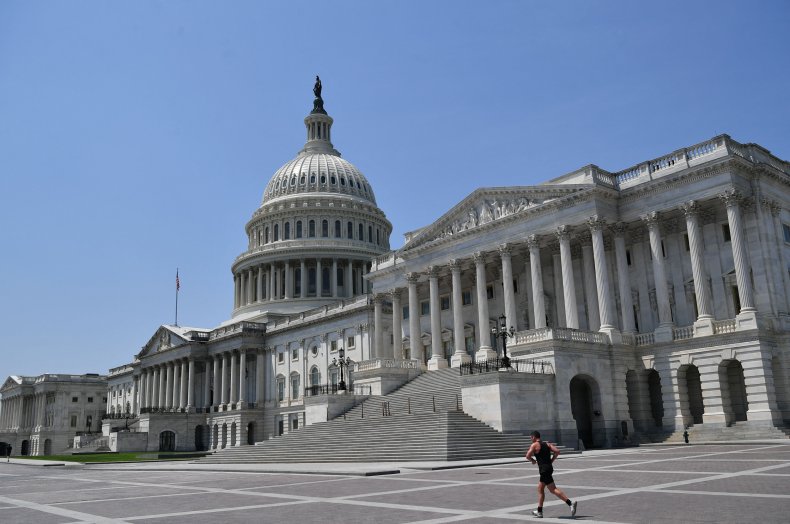With 100 days to the midterm elections, Republicans still look well-positioned to retake control of the House and possibly the Senate—although some recent polls also suggest Democrats may be able to hold onto their narrow majorities.
Democrats wrestled back control of the House in the 2018 midterm election under former President Donald Trump. They then managed to regain control of the Senate in the 2020 election and the January 2021 Georgia runoff, although the liberal party also lost a substantial number of seats in the House. Democrats currently control both chambers of Congress with the slimmest of margins—meaning even a handful of losses will be enough to flip control of the legislative branch of government.
Analysts have predicted for months—citing polling data and recent historical precedent—that Democrats are likely to lose control of the House and possibly the Senate when voters go to the polls on November 8. As President Joe Biden remains deeply unpopular, many see this as an indicator that Democrats will perform poorly as well.

MANDEL NGAN/AFP via Getty Images
Which Party Will Win the House?
On Sunday, CBS News released its 2022 Battleground Tracker, showing the GOP likely to pick up a significant number of House seats in the upcoming election. The news channel’s tracker currently shows that Republicans will gain an estimated 16 House seats, bringing their total to 230. Meanwhile, Democrats are predicted to lose those 16 seats, bring their total down to just 205.
News and polling analysis site FiveThirtyEight’s forecast shows Republicans are strongly favored to win back control of the House as well. The forecast gives the GOP an 83 in 100 chance of winning the majority, compared to 17 in 100 for Democrats.
“Even if Democrats were to win all the races currently designated as toss-ups, plus hold on to all the seats they’re favored to win, they would still wind up short of the number they need for a majority,” FiveThirtyEight’s analysis says .
Which Party Will Win the Senate?
Democrats appear to have a better chance of keeping control of the Senate, and possibly even expanding their majority. FiveThirtyEight’s forecast currently assesses that the party is “slightly favored” to maintain control of the upper chamber of Congress.
The site’s current prediction gives Democrats a 56 in 100 chance of winning the majority in the Senate, while Republicans have just a 44 in 100 chance. “The Senate race is close, and in a few key races, Republicans have selected weak candidates, hurting their chances of taking the chamber in November,” the analysis says.
What Do Recent Polls Show?
Recent generic congressional polling data is mixed, with some suggesting Democrats are favored by more voters, while many others show the GOP ahead. The margins vary significantly as well. The current Real Clear Politics average of recent national generic congressional ballot surveys shows Republicans with less than a 1-point advantage.
A poll conducted by Rasmussen Reports from July 24 to 28 shows Republicans with a 5-point advantage, however. That survey had the GOP at 46 percent and Democrats at only 41 percent. It included 2,500 likely voters with a margin of error of plus or minus 2 percent.
Another recent poll conducted by USAToday/Suffolk University from July 22 to 25 showed Democrats 4-points ahead. That survey had Democrats backed by 44 percent of registered voters compared to 40 percent who supported Republicans. Notably, the same poll carried out in mid-June showed Democrats and Republicans tied at 40 percent—meaning Democrats have gained 4 points.
The survey included 1,000 registered voters with a margin of error of plus or minus 3.1 percent.
Survey results from The Economist/YouGov from July 23 to 26 had Democrats 6-points ahead of Republicans. That poll showed the liberal party with 44 percent of support compared to 38 percent backing the conservative party. Again, that marked a shift in favor of Democrats. Earlier this month, the results were 43 percent for Democrats and 40 percent for Republicans, meaning Democrats gained 3 points.
The poll included 1,311 registered voters with a margin of error of plus or minus 3.1 points.
It’s important to point out that generic congressional ballot polls are an imprecise way to gauge which party is more likely to win in November. Each House race is decided in an individual district with its own particular dynamics, while race Senates are decided state-by-state. The national sentiments captured in these polls do, however, suggest that the country is fairly evenly split between the two dominant parties.
What About Historical Precedent?
The University of Virginia’s Center for Politics last June published an analysis of midterm elections going back to 1946. The report showed that the political party of a president serving in the White House, on average, loses more than 26 House seats during the midterm of their first term. The largest loss has been 64 seats, and the largest gain has been just eight seats.
That analysis showed correlated results in the Senate. The president’s party on average lost more than three seats in the Senate during the midterms. The biggest loss was 13 seats, and the largest gain was only four seats.
